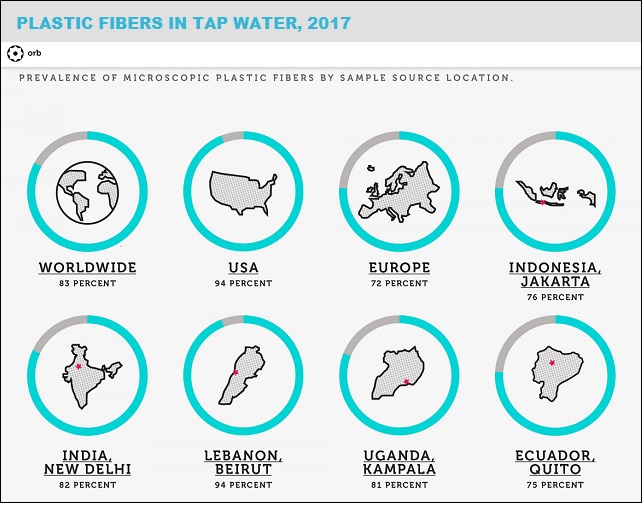
|
|

|
|
| April 25, 2024 |
|
Billions are drinking water contaminated with plastic — and US has it the worst 
If you drink tap water, you’re probably also ingesting potentially dangerous microscopic plastic fibers.
And you’re not alone: That’s likely the case for billions of people across the world, according to a new study from Orb Media. The study, conducted with researchers from the State University of New York and the University of Minnesota, tested 159 tap water samples from five different continents, according to Public Radio International. Of those samples, 83 percent were contaminated with plastic fibers, according to The Guardian, while the United States had the highest contamination rate at 94 percent. In the United States, plastic fibers were found in water samples collected from the U.S. Environmental Protection Agency’s headquarters, Congressional buildings and Trump Tower in New York. The countries with the next highest rates of contamination were India and Lebanon, while European countries, and specifically the United Kingdom, France and Germany, tended to have the lowest rates, according to the International Business Times. Out of every 500ml sample of water from the United States, researchers detected 4.8 plastic fibers, a dramatic increase over the 1.9 plastic fibers found in European water samples. Other countries with water samples in the study included Uganda (with 81 percent of samples contaminated), Ecuador (75 percent) and Indonesia (76 percent). These findings concerned Sherri Mason, a microplastic expert from State University of New York, who help oversee the Orb Media study. The most troubling part of the findings, Mason said, is that we aren’t exactly sure what damage the microplastics can inflict, but we likely have reason to worry. “We have enough data from looking at wildlife, and the impacts that it’s having on wildlife, to be concerned,” Mason said. “If it’s impacting [wildlife], then how do we think that it’s not going to somehow impact us?” Research on wild animals shows that microplastics contain chemicals that can be released into the body when digested, according to The Guardian. And there is reason to believe that the presence of microplastics could cause internal damage, Anne Marie Mahon, from the Galway-Mayo Institute of Technology, said to The Guardian. “If the fibers are there, it is possible that the nanoparticles are there too that we can’t measure,” she said. “Once they are in the nanometre range they can really penetrate a cell and that means they can penetrate organs, and that would be worrying.” No one knows for certain where the contaminating plastic fibers are coming from, but researchers have some ideas, including fibers shed by t-shirts and carpets. Another study from Plymouth University found that one cycle of a washing machine can release 700,000 fibers into the surrounding environment, according to The Guardian. Mary Kosuth, who performed tests for the Orb Media study at the University of Minnesota, wrote that this study is just the first step in determining how serious, and widespread, the issue of plastic contamination in tap water is. “Since this is the first global tap water survey of plastic pollution to have been completed, the results of this study serve as an initial glimpse at the consequences of human plastic use [and] disposal rather than a comprehensive assessment of global plastic contamination,” she wrote. “These results call for further testing within and between regions.” (Source: The Sacramento Bee) Story Date: September 7, 2017
|